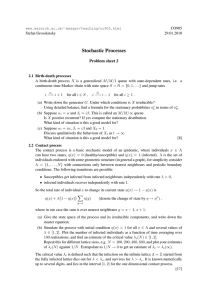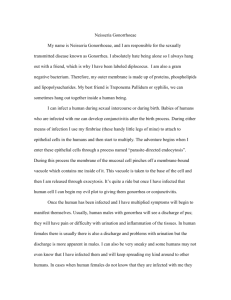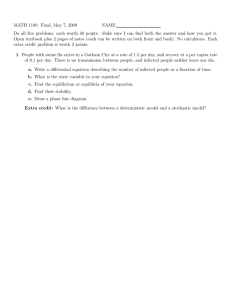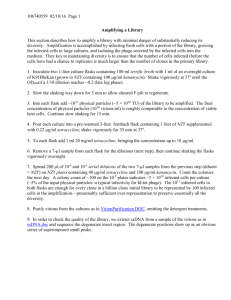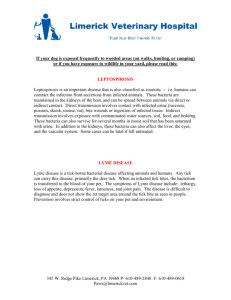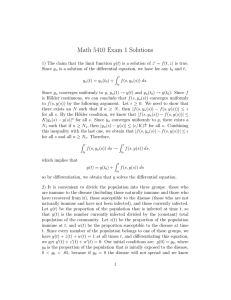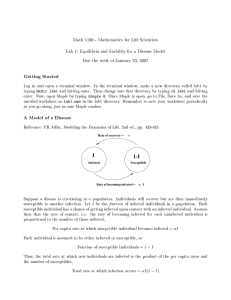Fitting Nonlinear Models to Data
advertisement
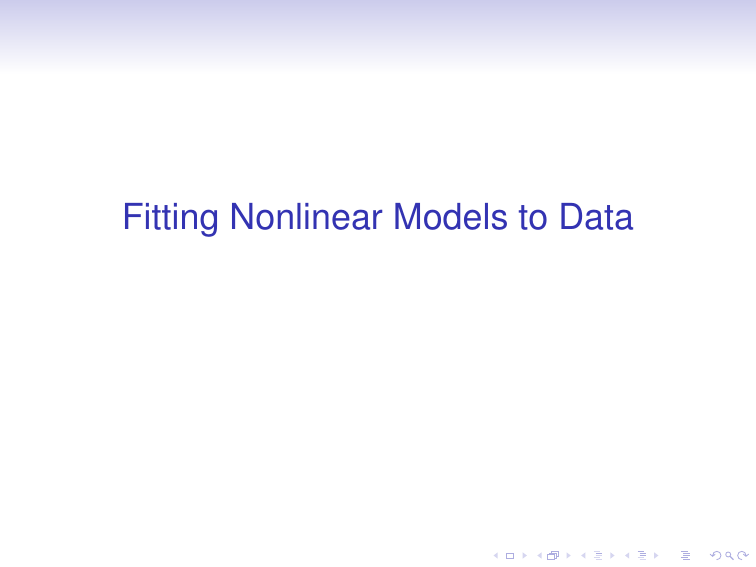
Fitting Nonlinear Models to Data SI Model • The SI model we discussed before is often written dS/dt = −pSI dI/dt = pSI where S is the “susceptible” population – those at risk to become infected at a given time – and I is the infectious population. For this model the sum S + I remains constant over time; we called the sum N and substituted S = N − I in the second equation. • The resulting solution was I(t) = NI(0) I(0) + [N − I(0)]e−pNt SIR Model • The SIR model (Kermack & McKendrick, 1927) is dS/dt = −pSI dI/dt = pSI − r I dR/dt = r I where R (for “recovered” or “removed”) is the number of people who were infected but are no longer infectuous. In this case, I + R is the cumulative number of people infected. • One can add a term to the first equation representing new arrivals to the susceptible population. • There is no formula for the solutions. Properties of Solution Families • Each model’s family of solutions has some properties that are useful for fitting parameters to data. • A time-shifted solution is also a solution: If I(t) is a solution, then I(t + c) is also a solution (with a different initial condition). This is because the model is “autonomous” – no explicit t dependence. • A rescaled solution is also a solution: If I(t) is a solution, then aI(bt) is a solution of the same model with different parameters. • Given a data set and the graph of a solution I(t), we can try to shift and rescale the graph to fit the data. Change of parameters for SI model solution • We can rewrite N 1 + [N/I(0) − 1]e−pNt N = = Ng(λ(t − δ)) 1 + e−λ(t−δ) I(t) = where λ = pN δ = log[N/I(0) − 1]/λ g(x) = 1/(1 + e−x ). Interpretation of new parameters • If we find parameters N, λ, δ that fit the data, we can solve for the original parameters p and I(0). However, the new parameters may be more interesting in their own right. • N is the total number of people who will be infected over the outbreak, according to the model. • δ is the time at which N/2 people have been infected, and at which dI/dt peaks; it is more relevant than I(0) to the data and to the intepretation of the model. • λ is the rate at which the outbreak unfolds; it represents the rate per unit time a single person is infecting others early in the outbreak. Data Fitting Problems • Given data points [tj , Ij ], where Ij is an estimate of the cumulative number of people infected at time tj , we can try to minimize the sum of squared residuals J X EI (N, λ, δ) = [Ij − Ng(λ(tj − δ))]2 . j=1 • If the data is [tj , yj ] where tj = j and yj is the number of new diagnoses per unit time, then we can fit dI/dt to the data by minimizing Ey (N, λ, δ) = J X j=1 [yj − Nλg 0 (λ(tj − δ))]2 . Partial Solution • We have posed nonlinear least squares problems. • Numerical methods for optimization can yield approximate minimizers N, λ, δ. • We can make some progress algebraically, since E is a quadratic function of N. Minimizing EI over N yields , J J X X Nλ,δ = Ij g(λ(tj − δ)) [g(λ(tj − δ))]2 . j=1 j=1 • Substituting and simplifying yields EI (Nλ,δ , λ, δ) = J X j=1 Ij2 − Nλ,δ J X j=1 Ij g(λ(tj − δ)). Simple Approaches to Minimizing E • Fix one parameter (say δ) and compute E(Nλ,δ , λ, δ) for various λ; look for the value of λ that minimizes E for the chosen value of δ. Then fix λ and adjust δ to make E as small as you can. Then go back and see if you can make E smaller by adjusting λ, etc. • Make a contour plot of E(Nλ,δ , λ, δ) over a range of plausible λ and δ values. Zoom in near the apparent minimum and make another contour plot, etc. • These approaches can be automated, and of course there are more sophisticated approaches; the latter become important when there are more parameters and/or when the function to be minimized takes a very long time to compute.

